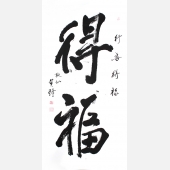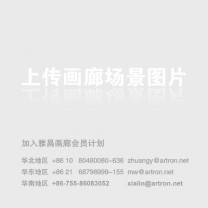兰正辉:当代与传统的对话
2011-04-15 11:49:00
(一)
在人类社会的初期,祖先们用画在砂石上的简单符号来表示他们的存在。之后,为了试图在所生存的世界中获得更多的影响力,人们开始在其居住的墙壁上刻画下更复杂的图形。后来,随着人们对世界的认识和控制能力不断增加,他们在居住的岩洞墙壁上画出了各种动物的图象。最终,当人类寻找到一种能够解释说明的,而不仅仅是直观表达的工具,他们创造的那些符号渐渐脱去了魔幻的外衣而演变为文字和书写。文字经过碰撞融合产生了诗歌。很快书写的吸引力超出字符本身的意义,各种字母和文字的书写成为美的表达方式。这便是书法的起源。
这一过程发生于世界许多地方,而在中国的黄河和长江流域,书法艺术达到了颠峰状态。中国的文字逐渐演化成其审美哲学的核心内容。当书法家的毛笔在纸上的各种曲直线条间自在舞动时,它离那个时代已经不远了——书法艺术卸下书写意义的担子,而转化成一种成熟的绘画形式。
然而,中国绘画的产生不同于西方古典绘画:与“认识”世界比起来,更注重于对未知神秘事物的探求。中国人对世界的理解是以人为中心的。他们眼中的自然界不是一个独立存在于身外的世界,也不是人类要带着距离感和征服欲所面对的地方,而是我们置身其中的一个世界,人类与它合为一体,是其中不可分的一部分。因此,不同于西方的强调对世界的客观分析,强调对事物物质层面的探求。中国文化中更注重主观的,非自然的,精神层面的东西。这对于绘画具有重要的影响。据此,对于中国艺术家来说,理解和表现世界的关键在于观察感知自然时加入自身情感。通过专注于观察现实世界他可能发现“势”,具有某种原则或本质的东西。一旦被发现,“势”将提供某种手段以直觉去认识整个自然世界。它会使画家手里的笔,将要表现的事物提炼成最简洁的线条形状,从而创造出一种即简练抽象,又比现实自然界更丰富的艺术——正如在中国风景绘画中表现的那样。
(二)
2009年3月12日到4月12日,欧豪斯画廊将为中国重要的当代书写表现艺术家兰正辉举办个展。正如他的作品所示他是一位当代艺术家,但从他的技巧及精神层面上看,同时也是中国传统书写绘画的继承者。与那些中国古代的绘画大师们一样,他坚持使用传统的纸,笔,墨。虽然在目前的展览中,在印尼创作的作品他改用了亚克力,他也只使用黑白两色。
兰正辉生于四川,并在那里度过青少年时代。他就读于四川美术学院,一个培养了许多杰出艺术家的中国著名学府。这里严谨科学的教育给了他一种分析式的,以人为中心的创作方法。在这里他学习以客观的方式来表现真实世界,并试图在其作品中表达深层次的自我。
在这种教育环境中也存在着矛盾。现代的,西式的教育理念显然同中国艺术传统中基于“势”的天地宇宙哲学的理念有差异。上世纪80年代初期,由于当局旧的愚民政策和文化专制,这种矛盾还没能显露出来。保守的社会现实主义统治着中国的艺术世界。80年代以后,随着国家的改革开放,管制的放松,一股自由文化的新思潮在中国的艺术院校传播开来。这就是著名的“85新浪潮”运动,新一代艺术家发起一场艺术的革命,给艺术世界领域带来一场风暴。年轻的兰正辉积极投入其中,成为他们中的一员。
除了中国传统与西方文化影响之间的潜在矛盾,还有一个存在于旧体制和新兴的改革阶层之间的矛盾。这一时期的中国艺术——85新潮一代——大部分是基于这些矛盾的揭露和表现。
一些人从这些矛盾中发现了一些可资利用的角度,他们用观念的方式把它表达出来。比如黄永砯,中国达达主义的代表人物,于1987年在他的代表作“中国美术史和现代西方艺术史在洗衣机里搅拌2分钟”——其结果为一堆无意义的烂纸浆——隐喻东西方文化相遇后不确定的情形。其他艺术家,如岳敏君是其中以体现旧体制和新兴阶层之间的矛盾,将艺术变为政治讽刺的工具而知名的。
兰正辉在这场运动中认识了自己,与当时的一些参与者成为朋友,其中很多已成为今天中国当代艺术的知名人士。他创作了具有一定哲学政治内涵的文字装置和观念艺术作品,因此参加了1988年的“黄山会议”,在这里,中国的85新一代艺术家们真正联合起来参与到这场运动中。之后的第二年,蓝参加了在北京举行的这次运动的第一次展览——中国现代艺术大展。但他很快厌倦了1989年新艺术运动的政治性氛围而离开南下广州。在那里他开始了长达近20年的构成中国文字的基本符号的研究,并整理出目录,这为他日后的创新打下了基础——书写性表现性绘画艺术。“大书写表现”已成为蓝的特有风格,也是这次展览的主题。
基于对艺术家以及整个新艺术运动的评论,兰正辉离开政治性的艺术氛围是一个重要的时刻。无论他是否意识到这点,也无论这是否影响了兰正辉的发展道路。不争的事实是,很多85运动的知名参与者被看作是“迎合”西方品味和政治观点。通过他们艺术作品中暴露的国家政体的矛盾,他们创造了一种新的有政治预期的艺术:中国政治波普。抛开其固有的艺术价值不谈,这无疑是中国新艺术在西方能如此成功的原因之一。
兰正辉的道路又是不同的。他试图通过自己的艺术解决中国传统与源于西方的现代表现之间的矛盾,而不是去直接表现中国当下社会的矛盾。他选择了间接的方式——行动绘画和后表现的方式。
这是一个自相矛盾的问题吗?是的,从表面看来是这样。当然中国书写性绘画是比喻性的,而非象美国抽象画家,或象法国超现实主义流派的传人那样去努力表达艺术家的潜意识。但二者之间有更深层的密切关系:在中国书法和西方的表现主义艺术中,都有经过一段专注的沉思之后出现突然爆发,通过较持久的最初能量积累后的释放。正是基于这种有着共性的“能量”,兰正辉得以将中西方的技巧和表达方式相结合,来创建他的作品和他的事业。
(三)
象前辈们那样,兰正辉在作品中坚持使用中国墨和宣纸。利用这些材料的吸收特性和水墨侵染的技巧,将各种阴影,微妙的变化和非象征的黑白结合的色块,带到其独特的视觉语言的探索中。他用的纸不仅是尺寸巨大——数米长两米多高——而且还使用艺术家自己改制的威力强大而灵活的笔刷,从而避免纸质的吸水性易碎性破坏创作效果。他所用的笔不是一般的毛笔,大的有一米多宽,(重到他拿不动为止)。他用笔在白纸上快速地挥洒,而生成一系列的长短变化的肌理纹路和类似几何状的块面图形,间或有墨滴散布其中。这种技巧的确大不同于中国传统的笔墨,后者轻舞于纸上,人物或朦胧风景便神奇的出现在柔软的笔锋之下。画的尺寸及所释放的能量大小也不能同日而语,在兰正辉的作品中所感悟到的能量要更直接和巨大得多。然而,除了外形和尺度的不同,所表达的精神本质是如此的类似:都与能量有关。还有一个重要的不同之处,是能量的释放采用不同的形式表达,从而使其功能各异。
如前面所示,传统的“势”在东方艺术中是主导一切的,而蓝的作品中能量的释放更多元化。结合集中能量的“势”的释放方式和表现主义粗矿的基于自我的表达方式,兰正辉率性的大笔刷创造性地表达了现代人类,中国人或非中国人关于存在的怀疑和焦虑。当面对有序和无序、内在和外在、精神力量的释放和自我怀疑,似乎艺术家正面对他内心的“镜子”,那里的自我毫无意义,而在生活的外界宇宙中,他也看不到任何意义,因此除了疯狂地画画来寻找意义,而别无选择。
当人类在文字图象形成以前,仅仅通过呼喊和岩壁上的符号来证明他们存在的时候,当人类还天真的没有成熟到发明“自我”或“宇宙”的概念时候,当上帝还没有被称为“上帝”,被肯定或否定的时侯,从这种意义上看,蓝的绘画可以看作是向昔日人类早期艺术意义深远的回归。
因此,今天这种由兰正辉创造的当代表现主义艺术形式与中国传统书写性表达方式走得如此靠近,其实一点都不奇怪。他的绘画是现当代性的能量和怀疑与传统相遇的结果。仅凭这个理由,这些作品的价值远超过只是随便看看。
(Jean Couteau,法国人类文化学教授。他的研究重点在人类学,哲学,社会政治等方面。从80年代开始多关注并撰写有关印度尼西亚,特别是巴厘岛的艺术方面文章。现居印度尼西亚巴厘岛。)
INILAH VERSI UNTUK DIPRINT----LAN ZHENG HUI'S ABSTRACTION: TRADITION VISITED BY MODERNITY
At the dawn of his history, Man announced his presence with swift marks on sand and stone. Then, in attempt to gain power over life and the world, he scratched esoteric crosses on the walls of his lair. Later, as he intensified his attempts at learning and controlling reality, the crosses became animals, drawn in the caves where he lived and loved. Finally, as he looked for a tool of explanation rather than expression, the signs he made little by little lost their magic to become words and writing. The words clashed and melted into one another to become poetry. Soon writing "exploded" beyond the meaning of its signs, letters and words to turn into beauty. It was the birth of calligraphy.
This took place all over the world. But it was in China, along the banks of the Hoang Ho and Yang Tse Kiang rivers, that calligraphy reached its peak. The written characters of the Chinese evolved to become the core of their aesthetics. As the brush of the calligrapher ran over the paper in ever extended curves and lines, it was not long before calligraphy freed itself from the burden of written meaning to transform itself into full-fledged painting.
Yet, the "Chinese" painting thus created was unlike Western classical painting: it was born less from an attempt at "knowing" the world than at entering its unknowable mystery. The Chinese perception of the world is not anthropocentric. Nature is not traditionally seen as something "out there" which Man faces with the consciousness of distance and the desire to conquer. It is on the contrary apprehended as something already "here", of which Man is an integral part. So instead of an emphasis on the objective, analytical and ultimately, the materialistic side of things, like in the West, there is in Chinese culture an emphasis on the subjective, synthetic and ultimately, the spiritual. This has had important consequences from the point of view of painting. According to the Chinese, the key, for the artist, to understanding and representing the world, is empathic observation of nature. It is only by fully concentrating on the phenomena of reality that he may discover the "shi", the principle or essence that underlies it. Once discovered, "shi" provides the means to intuit the reality of Nature as a whole. It leads the brush to synthesize represented objects to a minimum of lines and forms, creating an art both minimalist and more true to nature than Nature itself – as found in Chinese landscape painting.
Lan Zheng Hui, who is exhibiting at O'House between February 12.and March 12 is a modern painter, as shown by his abstract works, but he is also – in his technique, and partially, in his spirit – a direct heir to Chinese classical calligraphic painting. Like the masters of old, he too usually paints using traditional Chinese paper, brush and ink, although in the present exhibition, as Chinese paper is not readily available in Indonesia, he uses acrylic painting.
Born in Sichuan, where he also spent his youth, Lan Zheng Hui was educated at the Sichuan Academy of Fine Arts in what was known as the "Western" department of this academy. This means that his education provided him with an analytical and anthropocentric approach after the Western manner. He learnt to represent reality in an objective manner and to try to express in his works the depth of his own "self."
There was, in this education, a fundamental contradiction. The modern, Western-oriented type of education was obviously at odds with the "shi" inspired, cosmology-based approach of Chinese artistic tradition. Until the early 1980s, this contradiction could not be exposed, owing to the stultifying political and cultural hegemony of the Chinese Communist Party. Tradition was held to be opposed to progressive values, and a "decadent" offshoot of Western tradition, Social Realism, dominated the Chinese art world. In the 80s, however, political control relaxed, and a new spirit of cultural freedom spread over the campuses and art schools of the country. This was the onset of the famous "'85 New Wave" generation of artists who engineered a revolution in the arts that took the international art world by storm. Now based in Toronto, Lan Zheng Hui is a member of that 1985 generation.
Beside the latent contradiction between Chinese-ness and foreign cultural influences, there was another contradiction between the political control of the Communist Party and the development of a new, capitalist-oriented economic sector. Chinese art from this period – the 1985 generation – is largely based on the exploitation of these contradictions.
To some, those contradictions led to the absurd, a point that they gleefully made in a conceptual manner. Thus, Huang Yong Ping, nicknamed the Chinese Dada, presented in 1987 his famous "The History of Chinese Painting and the Concise History of Modern Western Art Washed in the Washing Machine for Two Minutes" – the result of which was an amorphous mound of paper pulp – as a metaphor for the no less amorphous situation following the meeting of Western and Chinese culture. Other artists, of whom Yue MiJun is arguably the most famous, exploited the growing contradictions between the communist political system and the new capitalistic economy by turning social realism on its head, thus turning their art into an instrument of political irony.
Lan Zheng Hui found himself in the middle of this scene and was a friend, whenever he came to Beijing, of many of its protagonists, today's stars of contemporary Chinese art. He had his own stints with installation and conceptual art with political connotations. This earned him invitations to participate in the 1988 "Huangshan Meeting" in Beijing, in which the New Chinese artists of the 1985 generation truly coalesced into a movement, and, the following year, the first exhibition of this movement in Beijing. Yet, he soon became weary of the political side of the new art and in 1989, he withdrew to Guangzhou in Southern China. There he started producing an inventory of basic graphs of the origins of Chinese characters, which led him in due time to the abstract reinvention of calligraphy that has now become his trademark, and is the topic of his present exhibition.
Lan Zheng Hui's withdrawal from political art was an important moment, because of what it says about the artist, and also, about the new Chinese art movement in general. Whether or not they were aware of it, and whether or not this influenced Lan Zheng Hui's evolution, it is indeed a fact that many of the star protagonists of the 1985 generation can be construed as "pandering" to Western taste and politics. By exposing in their art the contradictions of their country's regime, they created a kind of art that was politically "expected": Chinese Political Pop. Apart from its intrinsic qualities, it is undoubtedly one of the reasons why New Chinese art met with such success in the West.
Lan Zheng Hui's path was different. Instead of making art out of the contradictions of Chinese society, he would try through his art to overcome the latent contradictions between Chinese-ness and modern expression of Western parentage in art. And he did so by choosing abstraction – after the Action Painting/Abstract Expressionist manner.
Was this a paradox, yet another contradiction? Yes, but on the surface only. Of course Chinese calligraphic painting is figurative, and does not intend to express the artist's subconscious, as American Expressionists, as disciples of the French Surrealists, endeavored to do. But there is a deeper affinity: in both Chinese calligraphy and Abstract Expressionism, a meditative concentration phase is followed by a sudden, but often relatively long-lasting, phase of release of accumulated primal energy. It is on the basis of this common ground of "energy" that Lan Zheng Hui constructs his paintings, and his whole career, combining Western and Chinese techniques as well as Western and Chinese modes of expression.
Like the Chinese of old, Lan Zheng Hui normally uses Chinese ink and paper in his work. Exploiting the absorbent and blotting properties of these materials, employing a wash technique, he makes all the shades, nuances and combinations of non-figurative black and white into his particular visual field of exploration. The paper is not only of huge dimensions – several meters long and two meters high – but compels the artist to adopt a strong but swift brushstroke, lest the blotting quality of the paper's texture destroy the desired effect. His brush is no ordinary one. It too is huge, almost one meter wide, and he swipes it swiftly over the waiting paper, creating in the process a series of long see-sawed, streaked, semi-geometric patterns, sometimes interspersed by drips. This technique is indeed a far cry from the soft brush of Chinese tradition, which surges dancing over the paper as characters or misty landscape appear magically under its supple point. The scale is different, as is the amount of energy unleashed, much greater in Lan Zheng Hui's case. Yet, figuration and scale apart, the soul of the expression is similar: it is all about energy. Even though, and this is another important difference, the release of the energy is articulated differently and fulfills a different function.
As seen above, the "shi" of tradition is cosmic in orientation, whereas Lan Zheng Hui's energy release is more complex. Combining a "shi" release of concentrated energy with the wild ego-focused gesturing of Abstract Expressionism, Lan Zheng Hui's wild brush creatively expresses the existential doubts and anxieties of modern Man, Chinese or not. It is at once order/regularity and disorder, inner- and outer-centered, a release of mental power and of self-doubt. As if the artist were facing in his "inner" mirror an "ego" that had no meaning, and in his outer life, a cosmos in which he sees no meaning either, and has therefore no other choice than to paint wildly in search of Meaning.
In that sense, Lan Zheng Hui's painting can be construed as a sophisticated return to the situation of yore, at the dawn of Man. When Man manifested his existence only through shouts and marks on cave walls, before signs came into being. When Man was not naïve enough yet to have invented either a notion of "self" or a notion of "cosmos." When God was not yet called by name, affirmed or negated.
Thus, it is not the least bit paradoxical if what today comes the closest to Chinese classical calligraphic expression is a modernist form of abstraction of the kind practiced by Lan Zheng Hui. His painting is tradition visited by the energy and doubts of modernity. It is, if for this reason only, worth much more than a casual look.
Jean Couteau

 黄琦
黄琦 测试用艺术
测试用艺术
